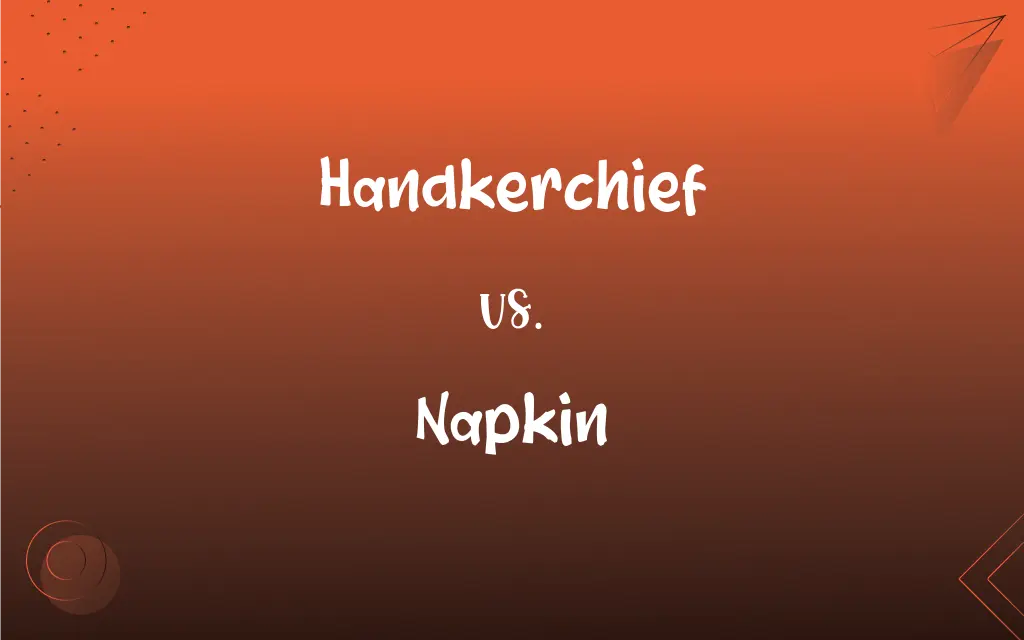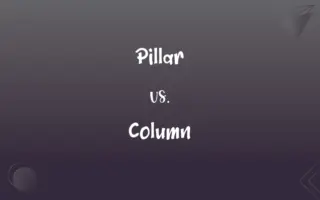Handkerchief vs. Napkin: What's the Difference?
Edited by Aimie Carlson || By Harlon Moss || Published on December 4, 2023
A handkerchief is a small fabric square typically used for personal hygiene, like wiping the face or nose, while a napkin is used during dining to wipe hands and mouth.

Key Differences
A handkerchief is traditionally a small square of cloth carried in the pocket or purse, primarily used for personal hygiene such as wiping the nose or face. A napkin, however, is a larger piece of cloth or paper used at the dining table to clean the hands and mouth during meals.
Handkerchiefs are often made from durable fabrics like cotton or silk, designed for repeated use and washes, signifying a personal accessory. In contrast, napkins can be disposable, made from paper, or made from cloth for use in more formal dining settings.
Historically, handkerchiefs have also served as a fashion accessory or a token in social and romantic interactions. Napkins, on the other hand, have always been utilitarian, evolving in their use and presentation in dining etiquette.
In terms of design, handkerchiefs may feature embroidered details or monograms, reflecting personal style or ownership. Napkins are generally simpler in design, focused more on functionality and complementing dining table decor.
The etiquette surrounding handkerchiefs involves personal cleanliness and discreet usage. For napkins, etiquette dictates their placement on the lap during a meal and how they are used to dab the mouth gently.
ADVERTISEMENT
Comparison Chart
Primary Use
Personal hygiene, like wiping the nose or face.
Cleaning hands and mouth during meals.
Material
Usually cotton or silk, designed for repeated use.
Cloth for formal dining, paper for casual or disposable use.
Historical Role
Fashion accessory, token in social interactions.
Strictly utilitarian, part of dining etiquette.
Design Elements
Can feature embroidery or monograms.
Generally simpler, complements table decor.
Etiquette
Used discreetly for personal cleanliness.
Placed on lap, used to dab mouth during dining.
ADVERTISEMENT
Handkerchief and Napkin Definitions
Handkerchief
A handkerchief can serve as a fashionable accessory.
She chose a silk handkerchief to match her outfit.
Napkin
Napkins can be decorative elements in table settings.
The napkins were folded into elegant shapes for the dinner party.
Handkerchief
Handkerchiefs are made from various fabrics like cotton or silk.
His cotton handkerchief was durable and soft.
Napkin
Cloth napkins are part of formal dining table settings.
Each place setting was adorned with a folded cloth napkin.
Handkerchief
Handkerchiefs are typically carried in a pocket or purse.
She always carried a handkerchief in her purse for emergencies.
Napkin
Napkins are essential in dining etiquette for cleanliness.
She dabbed her mouth with a napkin after eating.
Handkerchief
A handkerchief is a small cloth used for personal hygiene.
He pulled out his handkerchief to wipe his brow.
Napkin
Paper napkins are commonly used for casual dining settings.
The barbecue featured disposable paper napkins.
Handkerchief
In historical contexts, a handkerchief was often a token of affection.
The knight kept his lady's handkerchief as a memento.
Napkin
A piece of cloth or absorbent paper used at table to protect the clothes or wipe the lips and fingers.
Handkerchief
A small square of cloth used especially for wiping the nose or mouth.
Napkin
A cloth or towel.
Handkerchief
A large piece of cloth worn as a decorative article; a scarf.
Napkin
A sanitary napkin.
Handkerchief
A piece of cloth, usually square and often fine and elegant, carried for wiping the face, eyes, nose or hands.
Napkin
Chiefly British A diaper.
Handkerchief
A piece of cloth shaped like a handkerchief to be worn about the neck; a neckerchief or neckcloth.
Napkin
A serviette; a (usually rectangular) piece of cloth or paper used at the table for wiping the mouth and hands for cleanliness while eating.
Handkerchief
A piece of cloth, usually square and often fine and elegant, carried for wiping the face or hands.
Napkin
A nappy (UK), a diaper (American).
Handkerchief
A piece of cloth shaped like a handkerchief to be worn about the neck; a neckerchief; a neckcloth.
Napkin
A small scarf worn on the head by Christian women (chiefly Roman Catholic and Eastern Orthodox) when entering a church, as a token of modesty.
Handkerchief
A square piece of cloth used for wiping the eyes or nose or as a costume accessory
Napkin
A little towel, made of cloth or paper, esp. one for wiping the fingers and mouth at table.
Napkin
A handkerchief.
Napkin
To protect clothing; wipe mouth
Napkin
Garment consisting of a folded cloth drawn up between the legs and fastened at the waist; worn by infants to catch excrement
Napkin
A napkin is a piece of cloth or paper used during dining.
He unfolded his napkin as the meal began.
FAQs
How is a napkin used differently from a handkerchief?
A napkin is used during meals to clean hands and mouth, unlike the more personal use of a handkerchief.
Can handkerchiefs be decorative?
Yes, handkerchiefs can be decorative, featuring embroidery or monograms.
How do you choose a handkerchief for daily use?
Choose a handkerchief based on material, size, and comfort for daily use.
What is the main function of a handkerchief?
A handkerchief is primarily used for personal hygiene, like wiping the nose or face.
How often should cloth napkins be washed?
Cloth napkins should be washed after each use, especially in formal dining settings.
Is it appropriate to use a handkerchief at the dining table?
Typically, a napkin is preferred at the dining table, with handkerchiefs used for personal hygiene.
What's the etiquette for using napkins in restaurants?
In restaurants, place the napkin on your lap, and use it to gently dab your mouth.
Should paper napkins be recycled?
Paper napkins, especially if soiled, generally cannot be recycled and should be disposed of properly.
Can napkins be used for purposes other than dining?
While primarily for dining, napkins can be used for general cleaning tasks in casual settings.
Are napkins always made of cloth?
No, napkins can be made of paper, especially for casual dining, or cloth for formal settings.
Are there different folding styles for napkins?
Yes, napkins can be folded in various styles for decorative purposes in table settings.
Is it okay to share a handkerchief?
Sharing a handkerchief is generally discouraged for hygiene reasons.
Are handkerchiefs environmentally friendly?
Yes, handkerchiefs are reusable and can be more environmentally friendly than disposable tissues.
Can handkerchiefs signify social status?
Historically, handkerchiefs could signify social status based on the material and design.
What size are handkerchiefs typically?
Handkerchiefs are typically small squares, around 12 to 18 inches on each side.
Can a napkin be a centerpiece of table decor?
Yes, especially in formal dining, napkins can be central to table decor with elaborate folding and placement.
How are napkins and handkerchiefs similar?
Both are made of fabric and serve the purpose of cleaning, though in different contexts.
What fabrics are best for handkerchiefs?
Cotton and silk are popular choices for handkerchiefs due to their softness and absorbency.
How has the use of handkerchiefs evolved over time?
Handkerchiefs have evolved from a fashion accessory to primarily a practical item for personal hygiene.
Are there cultural differences in handkerchief usage?
Yes, handkerchief usage can vary culturally, with some cultures valuing them highly as personal hygiene tools.
About Author
Written by
Harlon MossHarlon is a seasoned quality moderator and accomplished content writer for Difference Wiki. An alumnus of the prestigious University of California, he earned his degree in Computer Science. Leveraging his academic background, Harlon brings a meticulous and informed perspective to his work, ensuring content accuracy and excellence.
Edited by
Aimie CarlsonAimie Carlson, holding a master's degree in English literature, is a fervent English language enthusiast. She lends her writing talents to Difference Wiki, a prominent website that specializes in comparisons, offering readers insightful analyses that both captivate and inform.































































